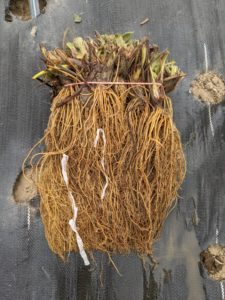
When I started the farm eight years ago, the one crop that I started with was strawberries (of the everbearing variety, also known as day-neutral.) I knew that there was a demand at the Middlebury Food Co-op for everbearing strawberries and at the time there was only one other farm that had just started growing them locally.
It was, and still is, a bit strange that so few farms grow everbearing strawberries in Vermont. They are not new. The variety I grow, Seascape, was developed in 1991 at UC Davis, though commercial everbearing as a variety were originally developed in the 1970s. Yet every year I have people ask me how I can possibly be growing strawberries for market anytime that is not June. It is not uncommon for me to get questioned if they are GMO, they are not.
Strawberries are a bit trickier than the average crop. I spend a lot more time preparing the field I will plant them into. This is because I use a woven fabric mulch on hilled beds. The mulch is a fairly effective weed barrier that also keeps the fruit clean and vastly improves the moisture levels in the soil. But the process of shaping the beds, laying down drip irrigation, pulling over and securing the mulch, and then planting the strawberries takes somewhere between 50 and 60 hours each year. I need to get the strawberries into the ground as soon as I can at the beginning of the season for them to start fruiting by mid July. This makes spring rather stressful because I also can’t bring the tractor into the field until the soils are dry enough. Otherwise I will cause damage to the soils through compaction that will be detrimental to the farm and ecology over the years.
Once I get the beds formed it is a good five days of planting. Just over five thousand plants are pushed root first into premade holes in the plastic mulch. It is…rather tedious. Though it can be a nice time to be outside in the spring.
This season I am experimenting with some A+ root stock because of some trouble with plant health last season. The A+ root stock is about two and a half times larger, which means significantly more root mass and the crowns are quite large. I planted the A+ rootstock alongside some regular rootstock to see how much better they produce. They look great though, I am optimistic that I am going to have a good crop.